Dumpling
This article needs additional citations for verification. (July 2008) |
 A fried dumpling filled with minced chicken and spring onion | |
| Main ingredients | Flour, potatoes or bread |
|---|---|


Dumpling is a broad classification for a dish that consists of small pieces of dough (made from a variety of starch sources), often wrapped around a filling (as in ravioli or wontons). The dough can be based on bread, flour, or potatoes, and may be filled with fish, meat, sweets, or vegetables. They may be cooked by boiling, frying, simmering, or steaming. Dumplings may be savoury or sweet and can be eaten by themselves, with gravy or sauce, or in soups or stews.
African cuisine
Banku and kenkey fit the definition of a dumpling in that they are starchy balls of dough that are steamed. They are formed from fermented cornmeal dough. Banku are boiled while kenkey are partly boiled then finished by steaming in banana leaves.[1]
Fufu may be described as a dumpling although in actual sense, it is not. Fufu is made by pounding boiled cassava (common in Ghana) or yam (common in Nigeria) in a wooden mortar with a wooden pestle. Plantain or cocoyam may be added. There are several other versions of fufu in Africa and the Caribbean. There have been other versions of fufu which will fit better into the definition of dumplings. These are mostly common outside Africa where they originate. It is made by steaming cassava and plantain/cocoyam flour into thick starchy balls.
Tihlo—prepared from roasted barley flour—originated in the Tigray region of Ethiopia and is now very popular in Amhara as well and spreading further south.[2]
Souskluitjies are dumplings found in South Africa. They are a steamed sweet dumpling, sometimes made with plain flour and sometimes with the addition of dried fruits or other flavors. They are often served with a syrup flavored with cinnamon or a custard sauce.[3][4]
South Africa has another kind of dumpling known as melkkos. These dumplings are formed by putting milk, one teaspoon at a time, into a dry flour mixture. The flour clings to the milk and forms dumplings, which are then boiled in a mixture of milk and butter. They are served hot and sprinkled with cinnamon sugar.[5]
American cuisine
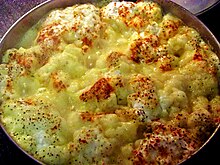
Several types of dumplings are popular in the United States. Dumplings can be made with eggs, milk, baking powder or even yeast, or just from flour and water. Rolled dumplings are rolled thin and cut into small pieces for cooking, while dropped dumplings are formed into small balls.[citation needed]
Spoonfuls or bite-sized, hand-torn pieces of dough are cooked in boiling chicken broth along with a variety of vegetables to make the dish chicken and dumplings, which is served as a thick soup or stew. Chicken and dumplings is a popular comfort food in the Midwestern and Southern U.S.,[citation needed] where dumplings are often used as part of the regionally popular Burgoo stew.[citation needed]
The baked dumpling is popular in American cuisine. These sweet dumplings are made by wrapping fruit, frequently a whole tart apple, in pastry, then baking until the pastry is browned and the filling is tender. As an alternative to simply baking them, these dumplings are surrounded by a sweet sauce in the baking dish, and may be basted during cooking. Popular flavours for apple dumplings include brown sugar, caramel, or cinnamon sauces.[citation needed]
Boiled dumplings are made from flour to form a dough. A pot of boiling chicken or turkey broth is used to cook this dough. The thickness and the size of the dumplings is at the cook's discretion. The size does not affect the taste but the thickness does. It is optional to serve with the meat in the dish or on the side.[citation needed]
Tortilla dumplings are made by adding tortillas and fillings to a boiling pot of stock. Popular varieties of Southern dumplings include chicken dumplings, turkey dumplings, strawberry dumplings, apple dumplings, ham dumplings, and even butter-bean dumplings.[citation needed]
Asian cuisine
Steamed dumplings are found throughout the region.[6]
Central Asian cuisine

Manti (also manty or mantu) is a steamed dumpling in Central Asian and Chinese Islamic cuisine. It contains a mixture of ground lamb (or beef) spiced with black pepper, enclosed in a dough wrapper. Manti are cooked in a multi-level steamer (mantovarka) and served topped with butter, yogurt, sour cream, or onion sauce. These dumplings are popular throughout Central Asia, including Afghanistan, Kazakhstan, Kyrgyzstan, Tajikistan, Uzbekistan, Xinjiang region of China and India.
Chuchvara is a very small boiled dumpling typical of Uzbek and Tajik cuisine. Made of unleavened dough squares filled with meat, it is similar to the Russian pelmeni and the Chinese wonton, but in observance of the Islamic dietary rules, the meat filling is without pork. Chuchvara can be served in a clear soup or on their own, with vinegar or sauce based on finely chopped greens, tomatoes and hot peppers. Another popular way of serving chuchvara is topped with suzma (strained qatiq) or with smetana (sour cream), Russian-style.
Chinese cuisine
A common legend goes that dumplings were first invented in the era of the Three Kingdoms, around 225 AD. Zhuge Liang, a general and minister of Shu Han, dammed up a poison marsh on his southern campaign against the Nanman with dumplings instead of the heads that the Nanman used.
The jiaozi () is a common Chinese dumpling which generally consists of minced meat and finely chopped vegetables wrapped into a piece of dough skin. The skin can be either thin and elastic or thicker. Popular meat fillings include ground meat (usually pork, but can instead be beef or chicken), shrimp, and even fish. Popular mixtures include pork with Chinese cabbage, pork with garlic chives, pork and shrimp with vegetables, pork with spring onion, garlic chives with scrambled eggs. Filling mixtures vary depending on personal tastes and region. Jiaozi are usually boiled, steamed or fried and continue to be a traditional dish eaten on Chinese New Year's Eve, the evening before Chinese New Year, and special family reunions. Particularly, in Northern China, people generally eat dumpling on the Winter Solstice (22 December of each year), a custom signifying a warm winter. Extended family members may gather together to make dumplings, and it is also eaten for farewell to family members or friends. In Northern China, dumplings are commonly eaten with a dipping sauce made of vinegar and chili oil or paste, and occasionally with some soy sauce added in.

If dumplings are laid flatly on a pan, first steamed with a lid on and with a thin layer of water, then fried in oil after the water has been evaporated, they are called guotie (鍋貼/锅贴, sometimes called "potstickers"), as the Maillard reaction occurring on the bottom of the dumplings makes the skin crispy and brown. The same dumplings are called jiaozi if they are just steamed.
The wonton (雲呑/餛飩) is another kind of dumpling. It is typically boiled in a light broth or soup and made with a meatier filling. The skin wrapping for wontons is different—thinner and less elastic—than that used for jiaozi [citation needed]. Wontons are more popular in Southern China (Shanghai, Guangdong, Hong Kong etc.) whereas in Northern China, jiaozi are more popular. Jiaozi, wonton and potstickers are all wrapped differently.

Another type of Chinese dumpling is made with glutinous rice. Usually, the glutinous rice dumplings zongzi (粽子) are triangle or cone shaped, can be filled with red bean paste, Chinese dates or cured meat depending on region. Glutinous rice dumplings are traditionally eaten during the Duanwu Festival. Other types of dumplings would be soup dumplings, commonly referred to as xiaolongbao (小籠包/小笼包).
Chinese cuisine includes sweet dumplings. Tangyuan are smaller dumplings made with glutinous rice flour and filled with sweet sesame, peanut, red bean paste. Tangyuan may also be served without a filling. Tangyuan are eaten on the 15th day of Chinese New Year, or the Lantern Festival.
See also: dim sum (點心) for descriptions of several other kinds of dumplings such as har gow, fun guo, siew mai, Cha siu bao, lo mai gai and crystal dumplings.
Indian cuisine
|
|
|
|
|
|
|
Indian cuisine features several dishes which could be characterised as dumplings:
- Ada (Malayalam) is a sweet South Indian dish from Kerala. Scrapped coconut mixed with sugar or jaggery is enveloped between the spread rice-dough and steamed. The sweet version of Kozhakkattai is equally famous in Kerala.[citation needed]
- Bhajia are dumplings sometimes stuffed with vegetables and fruits.[citation needed]
- Fara (Hindi) is famous in North India and is very similar to dumplings. It is made of wheat flour with stuffing of lentils and similar delicacies.[citation needed]
- Gujhia (Hindi) is a sweet dumpling made with wheat flour, stuffed with khoya.
- Kachori (Hindi) is a round flattened ball made of fine flour filled with a stuffing of baked mixture of yellow moong dal or Urad Dal (crushed and washed horse beans), besan (crushed and washed gram flour), black pepper, red chili powder, salt and other spices.
- Karanji (Marathi, Oriya) or Kajjikayi (Kannada, Telugu) or Kanoli are fried sweet dumplings made of wheat flour and stuffed with dry or moist coconut delicacies. They are a popular dish among Maharastrians, Oriyas and South Indians.
- Kozhakkattai (Tamil) or Kadabu (Kannada), is another South Indian dish that can be sweet, salty or spicy. The outer shell is always steamed sticky rice dough. In the sweet version, a form of sweet filling made with coconuts, boiled lentils and jaggery is used, whereas in the salty version, a mixture of steamed cracked lentils, chillies and some mild spices is used.
- Another dumpling popular in Western India and South India is the Modak (Marathi, Oriya) or Modhaka (Kannada) or Modagam (Tamil) or Sugiyan (Malayalam), Kudumu (Telugu) where the filling is made of fresh coconut and jaggery or sugar while the covering is steamed rice dough. It is eaten hot with ghee.
- Pidi (Malayalam) is another South Indian dish from Kerala that is usually eaten with chicken curry.
- Pitha (Bihari, Oriya, Bengali, Assamese) are stuffed savouries either made by steam or deep frying. A wide range of pithas are available in eastern and north eastern India.
- Samosa is another popular savoury snack eaten in the Indian Subcontinent and Iranian Plateau. It is a fried dumpling usually stuffed with mince, vegetables (mainly potatoes) and various other spices. Vegetarian variants of samosas, without the added mince stuffing, are also popular and are sold at most eateries or roadside stalls throughout the country.
- Momos are popular in the Darjeeling district and Sikkim state of India. The region has developed their own form; from the original Tibetan version.
Indonesian cuisine
Indonesian dumplings were influenced and brought by Chinese immigrants to Indonesia.
- Pangsit (wonton) is another type of dumpling that may be boiled, fried, or steamed, and often is used as complement of bakmi ayam or chicken noodle.
- Siomay is an Indonesian fish dumpling served in peanut sauce.
Filipino cuisine
Similar to Indonesia, the Chinese have brought dumplings to the Philippines since Pre-colonial times. It is also called Siomai which is made from ground pork, beef, shrimp, among others, combined with extenders like green peas, carrots and the like which is then wrapped in wonton wrappers. It is either steamed or fried and is usually dipped in soy sauce with calamansi juice.
Japanese cuisine

Dango (団子) is a sweet dumpling made from rice flour, similar to mochi. Dango is eaten year-round, but the different varieties are traditionally eaten in given seasons. Three to four dango are often served on a skewer.
Gyōza (ギョーザ/餃子) is the Japanese version of the Chinese jiaozi.
Korean cuisine
Korean dumplings are called "mandu" (만두). They are typically filled with a mixture of ingredients, including ground pork, kimchi, vegetables, cellophane noodles, but there are very many variations. Mandu can be steamed, fried, or boiled. The dumplings can also be used to make a soup called mandu guk (soup)(만둣국).[7]
Mongolian cuisine
Nepali cuisine
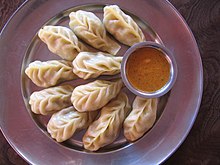
In Nepal, steamed dumplings known as momos (or momo-cha) are a popular snack, often eaten as a full meal as well. They are similar to the Chinese jiaozi or the Central Asian manti. The dish is native to Tibet and was brought to Nepal by the Newar traders of Kathmandu who were trading goods with Tibet before the 1930s. Many different fillings, both meat based and vegetarian are common. Kathmandu Valley, a popular destination for momos, has with time developed its own essence for this food that differentiates it from its Tibetan counterpart.
Momos can be both fried and steamed. Momos are usually served with a dipping sauce normally consisting of tomatoes and chillies as the base ingredient, from which numerous variations can be made. Momo soup is a dish that has steamed momos immersed in a meat broth. Momos that are pan fried after steaming first are known as kothey momo, and steamed momos served in a hot sauce are called C-Momo in Nepal. Momos can also be prepared by directly deep frying without steaming first. Momos are one of the most items on the menus of Nepalese restaurants not only in Nepal but also around the world with significant Nepali populations like India, USA, UK, Australia and some Middle Eastern and European countries.
Caribbean and Latin America cuisine
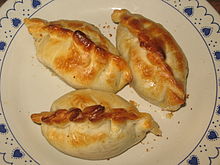
General
Empanadas, whose stuffing, manufacture and types are numerous and varied, differ from traditional dumplings in that they are deep fried or steamed, and excess dough is not cut off.
Barbadian cuisine
In Barbados, dumplings differ from those in other Caribbean islands in that they are slightly sweetened. The dumplings may either be of the flour or cornmeal variety. The dough is flavoured with spice, cinnamon and nutmeg. Dumplings are often added with Bajan soup where they are boiled. When found in Stew food, the dumplings are steamed along with ground provision, salted meat, plantain and other ingredients which is served with gravy.
Brazilian cuisine
In Brazil, there are pastéis, coxinhas, and bolinhas de carne which are fried dumplings filled with chicken, pork or beef mixed with olives, onions and spices. It is common to eat these on the beach or after work with fruit smoothies, beer, or fruity alcoholic drinks known as batidas.
Caribbean cuisine
Dumplings are either pan fried using a simple recipe including all-purpose flour, water, and salt made into a thick dough before frying on a pan until golden brown, or boiled in a soup. The fried version is usually served with breakfast codfish as a side.
Chilean cuisine
In Chile, there are pantrucas, a type of flat, elongated irregular dumplings flavoured with fresh parsley and served in soup.
Jamaican cuisine
Dumplings come in three forms in Jamaica, fried, boiled, and roasted. All are made with flour, white or wheat, and the white-floured dumplings are often mixed with a bit of cornmeal. These foods are often served with a variety of dishes like ackee and saltfish, kidneys, liver salt mackerel, etc. and often taste better when refried. A refried dumpling is an already boiled dumpling left over from previous cooking that is fried, which gives it a slightly crispy outer layer and a tender middle. A purely fried white flour dumpling (also known as a "Johnny Cake") is golden brown and looks a lot like buñuelos, often substituting the boiled dumpling, but it is mostly consumed as part of breakfast. Fried dumplings can be made with or without sugar. When mixed with sugar, cornmeal and baking powder and fried, this variation is called festival. This delicious variation goes well when served with fried fish, or any other traditional Jamaican home food.
It derived from the Akan cuisine of Bofrot, with the exclusion of vanilla and yeast. For Jamaican dumplings, however, sugar and butter is optional as there are various ways to make it in Jamaica.
Peruvian cuisine
"Papas Rellenas" or stuffed potatoes consist of a handful of mashed potatoes (without the milk and butter) flattened in the palm of the hand and stuffed with a savoury combination of ingredients. The stuffing usually consists of sautéed meat (could be beef, pork or chicken), onions and garlic. They are all seasoned with cumin, aji, raisins, peanuts, olives and sliced or chopped hard boiled eggs. After stuffing a ball is formed, rolled over flour and deep fried in hot oil. The stuffed potatoes are usually accompanied by onion sauce consisting of sliced onions, lime juice, olive oil, salt, pepper and slices of fresh peppers. The same dish may also be made with seafood. In some countries, yuca purée is used as the starch component of these Latin American dumplings.
Puerto Rican cuisine
In Puerto Rico, dumplings are made of grated tubers such as yuca and malanga with added calabaza, unripe bananas and plantains mixed with flour. These dumplings are a traditional part in Puerto Rican style pigeon pea soup. Olive oil and annatto are usually added and help the mix from turning brown. The dumplings are formed into small balls and are first cooked in olive oil before boiling. Once the dumplings are crispy on the outside, they are then boiled with added ingredients.
Another dumpling that originated in Puerto Rico is the pasteles, a dumpling made of grated root vegetables, squash, plantains, and unripe bananas. The masa is then mixed with milk and annatto oil, and they are stuffed with stewed pork, chick peas, olives, capers and raisins. They are then placed on a banana leaf, tied and then boiled. The origin of pasteles leads back to Natives on the island of Borikén. Pasteles are popular in the Dominican Republic, Hawaii, Trinidad and lately seen in Cuban cuisine.
European cuisine
British and Irish cuisine
Savoury dumplings made from balls of dough are part of traditional British and Irish cuisine. Traditionally dumplings are made from twice the weight of self raising flour to suet, bound together by cold water to form a dough and seasoned with salt and pepper. Balls of this dough are dropped into a bubbling pot of stew or soup, or into a casserole. They sit, partly submerged in the stew, and expand as they are half-boiled half-steamed for ten minutes or so. The cooked dumplings are airy on the inside and moist on the outside. The dough may be flavoured with herbs, or it may have cheese pressed into its centre.
After beef stew is finished, a pudding can be created by topping the dumplings and gravy with sugar.[citation needed]
The Norfolk dumpling is not made with fat, but from flour and a raising agent.[8] Cotswold dumplings call for the addition of breadcrumbs and cheese, and the balls of dough may be rolled in breadcrumbs and fried, rather than cooked in a soup or stew.[9] Vegetarian dumplings can be made with vegetable suet, a type of shredded vegetable fat. When sweetened with dried fruit and spices, dumplings can be boiled in water to make a dessert. In Scotland, this is called a clootie dumpling, after the cloth.[10]
Central European cuisine

Germany, Romania, Austria, the Czech Republic and Slovakia boast a large variety of dumplings, both sweet and savoury. A dumpling is called Kloß in Northern Germany, Knödel, Nockerl or Knöpfle in Southern Germany and Austria. These are flour dumplings, the most common dumplings, thin or thick, made with eggs and semolina flour, boiled in water. Meat dumplings (called Klopse or Klöpse in North-Eastern Germany, Knöpfle and Nocken in Southern Germany) contain meat or liver. Liver dumplings are frequent additions to soup. Thüringer Klöße are made from raw or boiled potatoes, or a mixture of both, and are often filled with croutons. Bread dumplings are made with white bread and are sometimes shaped like a loaf of bread, and boiled in a napkin, in which case they are known as napkin dumplings (Serviettenknödel).
Maultaschen are a Swabian (Baden-Württemberg) specialty food, consisting of an outer layer of pasta dough with a filling traditionally made of sausage meat, spinach, bread crumbs and onions and flavored with various spices. Similar in appearance to Italian ravioli, Maultaschen are usually larger, however, each Maultasche being about 8–12 cm (3-5 inches) across.
The only potato dumpling museum in the world, the Thüringer Kloßmuseum, is located in Germany, in the municipality of Heichelheim near Weimar.

Halušky are a traditional variety of dumplings cooked in the Central and Eastern European cuisines (Czech Republic, Hungary, Poland, Romania, Serbia, Slovakia, and Ukraine). These are small lumps cut from a thick flour and egg batter and dropped into boiling water, similar to the German Spätzle, Knöpfle, or Knödel.

In Romania, the dumplings are with plums inside and are called galusca cu prune, while in in Hungary, they are called nokedli. Sweet varieties called gombóc are made with flour and potato dough, which is wrapped around whole plums or apricots, and then boiled and rolled in hot buttered bread crumbs. Shlishkes or "Krumplinudli" are small boiled potato dumplings made from the same potato dough as the sweet plum dumplings, also rolled in hot buttered bread crumbs.
Bryndzové halušky, considered the Slovak national dish, are small potato dumplings without a filling, served with salty sheep's cheese on top. The same dumplings are also used to create a similar dish, strapačky. Also available are their related stuffed version called pirohy, usually filled with bryndza (bryndzové pirohy), quark cheese, potatoes, onions, cabbage, mushrooms, or meat.

In Czech cuisine dumplings have two main forms:
- Knödel is called in Czech knedlík and in Slovakia knedlička. It can be either houskový (bread) or bramborový (potato) knödel. These dumplings are boiled in loaf shape and then cut in slices and are part of many Czech national dishes such as Vepřo knedlo zelo or Svíčková na smetaně.
- Ovocné knedlíky (ball-shaped knedle) filled in with fruit: plums, strawberry, blueberry etc. Meal is completed on plate with grated quark, melted butter and powder sugar.
Idrijski žlikrofi are Slovenian dumplings, regionally located in the town of Idrija. They are made from dough with potato filling and have a characteristic form of a hat. Žlikrofi are made by a traditional recipe from the 19th century, but the source of the recipe is unknown due to lack of historical sources. The dish may be served as a starter or a side dish to meat based dishes. Žlikrofi were the first Slovenian food to be classified as a Traditional speciality guaranteed dish.
Eastern European cuisine
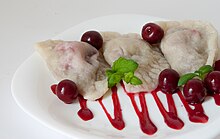
Pierogi of Poland and varenyky of Ukraine, Russia and Belarus are ravioli-like crescent-shaped dumplings filled with savoury or sweet filling. Varenyky are usually boiled or steamed. Pierogi are often fried after boiling.
"Little ears", variously called uszka in Poland, ushki (ушки) in Russia, vushka (вушка) in Ukraine, and vushki (вушкі) in Belarus, are folded ring-shaped dumplings similar in shape to Italian tortellini or Jewish kreplach. They are stuffed with meat or mushrooms and traditionally served in borshch or clear soup. In Romania, "little ears" (Template:Lang-ro) are also served in dumpling soup (supă de găluşte)
Kluski are a different variety of Polish dumplings.

Lithuanian dough dumplings are called koldūnai and virtiniai. Usually they are filled with meat or curd. One of the varieties is called Šaltanosiai, "Cold nosed ones", and is made with blueberry filling. There are also potato dumplings called cepelinai or didžkukuliai, filled with meat or curd inside, served with soured cream. A similar dish exists in Belarus that is called klyocki (клёцкi).
Russian pelmeni are smaller than varenyky and made only of minced meat with addition of onions and spices. Sometimes the meat used is only beef, in other recipes is a mixture of beef with pork and/or mutton. Pelmeni should be juicy inside. They are unrelated to the pasta with which they are sometimes compared as it is a savoury main dish. They are usually boiled in water with spices and salt, or in meat bouillon, sometimes fried before serving. They are often served with plenty of sour cream.
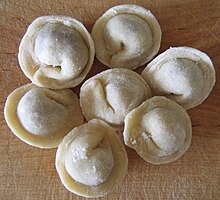
An important difference between pelmeni, varenyky, and pierogi is the thickness of the dough shell—in pelmeni this is as thin as possible, and the proportion of filling to dough is usually higher.[11] Pelmeni are never served with a sweet filling, which distinguishes them from varenyky and pierogi, which sometimes are. Also, the fillings in pelmeni are usually raw, while the fillings of vareniki and pierogi are typically precooked.
The word pelmeni is derived from pel'n'an' (пельнянь) – literally "ear bread" in the native Finno-Ugric Komi, Udmurt, and Mansi languages.[12][13] It is unclear when pelmeni entered the cuisines of the indigenous Siberian people and when they first appeared in Russian cuisine. One theory suggests pelmeni, or stuffed boiled dumplings in general, originated in Siberia, possibly a simplified adaptation of the Chinese Wonton (in some dialect is called Bāomiàn "包面"). Pelmeni are particularly good means of quickly preserving meat during long Siberian winter, especially eliminating the need to feed livestock during the long winter months.
The main difference between pelmeni and momos is their size—a typical pelmeni is about 2 to 3 centimetres (0.79 to 1.18 in) in diameter, whereas momos are often at least twice that size.
In Siberia, especially popular with the Buryat peoples are steamed dumplings called pozi (buuz in Mongolian, from Chinese: 包子; pinyin: bāozi). They are usually made with an unleavened dough, but are often encountered leavened. The traditional filling is meat, but the kind of meat and how it is processed varies. In Mongolia, mutton is favored, and is chopped rather than ground; pork and beef mixes are more popular in Russia.
Manti, samsa, chiburekki, and belyashi are all popular imported dumplings.
Italian cuisine

Ravioli and tortellini fit the basic definition of a dumpling: these are pockets of pasta enclosing various fillings (cheese, mushrooms, spinach, seafood, or meat). Instead of being made from a ball of dough, the dough is rolled flat, cut into a shape, filled with other ingredients, and then the dough is closed around the filling.
Gnocchi (Template:Lang-es, widely adopted in Argentina, Template:Lang-pt, Template:Lang-sl) is a different kind of Italian dumpling. The word gnocchi literally means "lumps", and they are rolled and shaped from a mixture of egg with potato, semolina, flour, or ricotta cheese (with or without spinach). The lumps are boiled in water and served with melted butter, grated cheese, or other pasta sauces.
Scandinavian cuisine
Norway
In Norway, dumplings have a vast variety of names, as the dialects differ substantially. Names include potetball, klubb, kløbb, raspeball, komle, kumle, kompe, kumpe, kodla, kudle, klot, kams, ball, baill, komperdøse, kumperdøse, kompadøs, ruter, ruta, raskekako, risk, klotremat, krumme and kromme. They are usually made from crushed potatoes mixed with various types of flour, often with an emphasis on barley and wheat. In some local recipes the potatoes are dehydrated, while in others there is a mixture of raw and boiled potatoes. Occasionally they are filled with bacon. Depending on local tradition, dumplings can be sided with syrup, swede and often meat if the dumplings does not have meat filling.
Sweden
In Sweden, potato dumplings of originally German origin[14] have several regional names, mainly depending on the type of flour used. When the potato is mixed with wheat flour, which is more common in southern Sweden, it is called kroppkaka. In Blekinge[15] and parts of the island of Öland, it is traditionally made from grated raw potato, which makes it greyish in colour, while on Gotland and in Småland it is predominantly made from mashed boiled potato, and is thus whiter in colour.[14] The kroppkaka is usually filled with diced, smoked bacon and chopped, raw onion, and is often spiced with allspice.[14]

When the potato is mixed with barley flour, which is traditional in northern Sweden, it is known as palt in Lapland, Västerbotten and Norrbotten,[14] and as kams in Jämtland, Ångermanland and Medelpad.[14][16] Originally, palt was eaten all over Sweden and was made from barley or rye flour alone, but during the 19th century, when potato was added and wheat became more common and inexpensive, the northern recipes retained the original name, while kroppkaka, which had always been the name used on Öland for the flour dumpling, became the name for the variant in southern Sweden.[17]
Palt and kams is usually filled with diced, unsmoked bacon. However, sometimes fried bacon is served on the side of unfilled palt or kams, which then is known as flatpalt or flatkams, as the lack of filling makes it flatter. The most well-known palt variant is the Pitepalt from Piteå. In Dalarna, where the dish is known as klabbe, it is still made without potatoes and is never filled. Klabbe is instead served with diced bacon on the side.[18]
A variant of palt is blodpalt, where pig, beef or reindeer blood is mixed into the dough. Other palt variants are leverpalt, with minced liver added to the dough, and njurpalt, with diced kidney mixed into the bacon filling.[14] Blodpalt also existed across the country originally, and has been found in iron age graves in Halland.[16]
The filled kroppkaka, palt or kams ball - as well as the flatter, unfilled flatpalt, flatkams and klabbe - is dropped into boiling salted water and cooked until it floats. It is traditionally served warm with melted butter and lingonberry jam, although in some parts of southern Sweden the melted butter is replaced by half cream (a mix of milk and cream) or a warm milk sauce, and in parts of northern Sweden the butter is replaced by a warm milk sauce spiced with messmör. Leftover kroppkaka is often served halved and fried.[14]
Unfilled flour dumplings for use in soup are called klimp if the flour is wheat, but mjölpalt if the flour is barley or rye.[14]
Middle Eastern cuisine
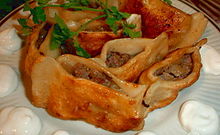
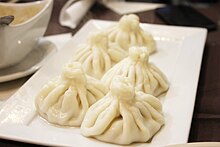
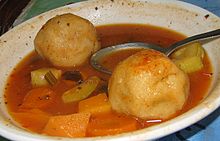
Arabic cuisine
Caucasian cuisine
Meat-filled manti in Armenia are typically served with yogurt or sour cream, accompanied by clear soup. Mantapour is an Armenian beef soup with manta.
Boraki (Template:Lang-hy) are a kind of Armenian fried dumplings. The main distinction of boraki is that the minced meat is pre-fried, the boraki are formed as small cylinders with an open top, the cylinders are lightly boiled in broth and then fried. Boraki are served garnished with yogurt and chopped garlic.[19]
Dushbara (Azerbaijan: Düşbərə) is an Azeri soup with tiny lamb-filled dumplings.[20]
Khinkali (Georgian: ხინკალი) are Georgian dumplings usually filled with spiced meat. herbs (usually coriander), onions, and garlic. Mushrooms, potatoes, or cheese may be used in place of meat. The khinkali is typically consumed first by sucking the juices while taking the first bite, in order to prevent the dumpling from bursting. The towns of Dusheti, Pasanauri and Mtskheta are particularly famous for their khinkali.
Mataz are dumplings in Circassian and some other Caucasian cuisines, closely related to manti. They typically consist of a spiced meat mixture, usually lamb or ground beef, with greens and onions, put in a dough wrapper, either boiled or steamed. Mushrooms, potatoes, or cheese may be used in place of meat.
Jewish cuisine
Turkish cuisine
See also
- Gulab jamun, a sweet, similar to a dumpling but made from milk solids
- List of dumplings
- List of foods
- Pie
References
- ^ "Banku & Kenkey".
- ^ "Culture of the people of Tigrai". Tigrai Online. Retrieved 3 January 2013.
- ^ "Souskluitjies Dumplings In Cinnamon Syrup) Recipe - Dessert.Food.com".
- ^ "Souskluitjies South African Dumplings In Custard Sauce) Recipe - Food.com".
- ^ http://www.godsglory.org/Recipes.htm
- ^ Williams, Sean (2006). The Ethnomusicologists' Cookbook: Complete Meals from Around the World. CRC Press. p. 59. ISBN 9780415978194. Retrieved 10 February 2013.
- ^ http://www.faqs.org/photo-dict/photofiles/list/3205/4262mandu.jpg
- ^ "Norfolk Dumplings Recipe". The Green Chronicle. Retrieved 20 July 2008.
- ^ "Cotswold Dumpling Recipe". The Green Chronicle. Retrieved 20 July 2008.
- ^ Cropley, May. "Clootie Dumpling Recipe". Retrieved 20 July 2008.
- ^ 'Пельменів не буде — будуть равіолі?' Template:Uk icon
- ^ Dal Dictionary on-line derives the etymology of pel'men' from pel'=ear and nan'=bread in Komi and Mansi (Vogul) languages. This may be why pelmeni are called uszka ("ears") in Poland.
- ^ Also in Max Vasmer's etymological dictionary of the Russian language. See: пельмень - Этимологический онлайн-словарь русского языка Макса Фасмера Template:Ref-ru
- ^ a b c d e f g h Kunskapskokboken: Om kroppkakor, palt & kams (Swedish only) Linked 13 April 2015
- ^ In the Kitch, 19 February 2013: Kroppkakor från Blekinge (Swedish only) - Linked 13 April 2015
- ^ a b Smaka Sverige: Palt/Kams (Swedish only) Linked 13 April 2015
- ^ Smaka Sverige: Kroppkakor (Swedish only) Linked 13 April 2015
- ^ Matklubben.se: Klabbe med fläsk och messmörsås (Swedish only) Linked 13 April 2015
- ^ Boraki Template:Ru icon
- ^ http://azer.com/aiweb/categories/magazine/83_folder/83_articles/83_254.html Dushbara in Azerbaijani cuisine. Retrieved on 5 April 2009






